June 25 – Wednesday – Set Sail for Svirstroy
After breakfast, the ship program features a couple of gals from the ship gift shop explaining and showing us Russian handicrafts. Strangely enough all the items are available for purchase!
At 10, Captain Constantin and Garon, the hotel director give a slideshow talk about the Russian waterways and the 16 locks we’ll be passing through. The Captain was up all night steering the ship, but is in great spirits for the talk. He is a most happy man and very well loved.
At 11:00 Yulia gives a port talk on Svirstroy – followed by a Russian Language lesson. Both sessions were good, but I keep dozing off.
We have a huge lunch at 12:00 – Gluttony rules!
After lunch, the ship goes through its first lock on the Svir River. It connects the two largest lakes in Europe – Lake Ladoga and Lake Onega. In spite of the rain, there is much excitement. The boat enters a gate where the water levels are very low. The gate shuts, then the other gate opens and the water flows in. It’s like the ship is going up an elevator. Crazy technology – who thought of that?!?!

Svir River Locks |
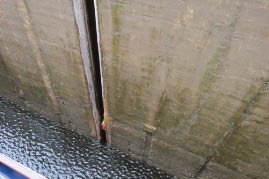
Svir River Locks |

Svir River Locks |

Svir River Locks |
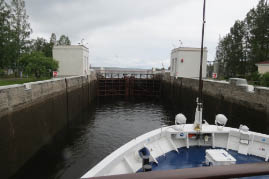
Svir River Locks |

Svir River Locks |
At we 2 p.m. we disembark and find ourselves in Svirstroy, a small village of about 1,000 residents located on the Svir River. The village of Svirstroy is about 150 miles east of St. Petersburg and feels like it’s in the middle of nowhere.

Svirstroy |

The other NiNi with the ship’s pianist / photographer (Yes, there is another NiNi and PaPa in this world!) |
Bill and I have about an hour to walk through Svirstroy on our own. It’s a typical settlement for the region – a multi-national population including Russian, Finnish and Karelian. The kids here are growing up and moving to the big cities for work.
Of course, it’s cold and rainy. We stop at a few shopping kiosks designed like log cabins strategically placed by the dock and at the entrance to the town. We buy some birch carved boxes from the artisan himself. We also buy some nesting dolls. This small local craft market is the life blood for the whole region. The locals are learning capitalism very well.

Svirstroy |

Svirstroy |
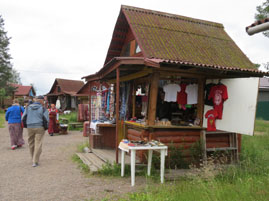
Svirstroy |

Svirstroy |

Svirstroy |

Svirstroy |
We stop at the town’s mini square where there is a statue of Sergei Kirov. In 1926, Kirov was the leader of the Leningrad Communist Party Organization and considered the second person in line after Stalin. However, he was murdered in his office. Some say it was a terrorist plot. Some say he was a well-known womanizer and an irate husband got to him. But most believe Stalin was behind the deed. Stalin wasn’t fond of competition. In any case, Kirov’s image occupies a spot in Svirstroy because in the early 20’s, Kirov came here to establish a large scale plan for constructing hydroelectric stations. In 1933, the station began to produce electricity and the lock gates were open for the first ships. (We’re using them now.)

Sergei Kirov |

Sergei Kirov |
During WWII, Svirstroy was occupied and destroyed by the Germans. But after the war, people returned to this remote place to reconstruct the hydroelectric station (designed and restored by academician Graftio). The houses were re-built, thanks mainly to the German POWs that were imprisoned nearby.
The houses are now badly in need of repair. I saw what looked like quaint country houses surrounded by lovely flower and vegetable gardens. Later I learned that each house is divided into about 4 or 5 apartments with families packed into 2 rooms. The people pour so much love into tending the gardens. There are several makeshift plastic green houses for growing seedlings and protecting some plants from the brutal cold.

Svirstroy |

Svirstroy |

Svirstroy |

Svirstroy |

Svirstroy |
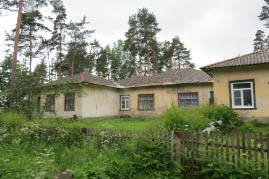
Svirstroy |

Svirstroy |

Svirstroy |

Svirstroy |

Svirstroy |
In spite of the drizzle, it was a pleasant walk past the gardens and through the forested town along the riverfront. We passed a WWII memorial, a church and a couple of stores mixed in with the houses. A couple of boys on their bikes practice their English with us and show off their bike riding skills.

Svirstroy |

Svirstroy |

Svirstroy |

Svirstroy |

Svirstroy |

Svirstroy |
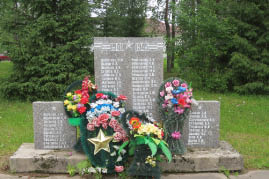
Svirstroy |

Svirstroy |

Svirstroy |
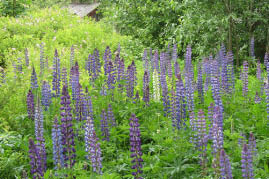
Svirstroy |

Photographers by Night, Musicians by Night |

Another silly little yapping dog to make me miss Molly |

Svirstroy |
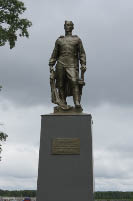
Svirstroy |
We meet with the group at the town square and walk together down to Tomar’s house to have Russian tea. Tomar gives us a warm welcome at her house – one apartment tucked into a house of about 4 apartments. We crowd into one of the rooms that serve as a bedroom at night. The table is loaded with treats – all made by Tomar -- even the jams. There are candies, oatmeal cookies, ginger snaps and piroshkies – the regional specialty. Piroshki (Russian meaning - “peer feast”) are pastries filled with cabbage, chicken, fish, fruit, or mashed potatoes. They warmed our hearts, and so did Tomar.

The Americans are Coming! |
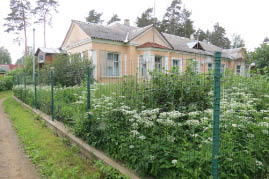
Tomar's House |

Visit to Tomar's House |

Piroshkies |

Visit to Tomar's House |

Visit to Tomar's House |

Visit to Tomar's House |

Tomar's |

Visit to Tomar's House |

Visit to Tomar's House |
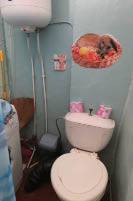
Visit to Tomar's House |
Tomar’s Story
Tomar has been working at a local orphanage nearby for about 25 years. She is divorced – She says she is “free of men.” She has one daughter in her last year of college studying to be an accountant. Her daughter was born in 1991 – the time of utter chaos in Russia when the Soviet Union was collapsing. When we ask what that was it like for her back then, tears came quickly. She said they all worked hard, but many times they didn’t get paid. She didn’t even have enough money for milk for the baby. We quickly changed the subject.
She said she loves her town and misses it on the rare times she is traveling. She adores cross country skiing – and loves nature. With great love, she told us about working with orphans. She said most children become orphans because of an alcoholic father.
She told us that she is close to retiring and wants to know what it is like to retire in the U.S. and then asked if our children paid for our trip to Russia. That brought the house down because most folks in our group help their children out and couldn’t imagine the reverse. We gave her the presents we brought and then said good-bye, feeling closer to the real Russian people who work so hard just to survive. It is only by accident of birth that we are fat and sassy and think there’s no tomorrow.
|
We come back to the boat and attend a talk on Russian history – focusing on the Tsars in the Russian Empire all the way to the October Revolution in 1917. Jenia, the most amazing, talented guide, unfolded a riveting story. She had us sleeping old folks wide awake hanging on every word. We all left dumbfounded and awed by her knowledge and presentation.

Back to the Boat |

Our Leaders |
We scurry back to the room to get ready for dinner. It’s Russia Dress up night. I have nothing that even comes close to a Russian outfit, but I want to be part of the Russian Custom Party Gala. The shiny gold bedspread inspires me to be Catherine the Great. I throw the bedspread over my shoulders as a royal robe and put together a crown using the free shower caps as a base. Needless to say, Bill does not support me in this endeavor. He puts his foot down when I try to make the lamp into my secpture – so the lamp stays in the room.
We are greeted at the dining door with music and dancing Russian ladies. We find a seat with Bob and Joan and the couple from Beverly Hills with their relatives (some from Michigan) who join us. We have a lovely dinner. They don’t know I’m Catherine the Great until Joan helps me assemble my costume for the after dinner modeling show. Joan carries my robe. For our silliness, we each get a shot of Vodka – such great fun.
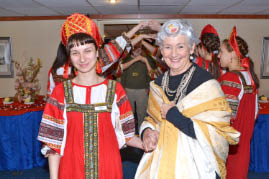
Catherine the Great (the one on the right) |
We go to the after dinner concert to hear the accordion player and banjo guy. They are musicians by night and photographers by day. The accordion guy had the goofiest smile. Later, the MC said he is the top student in Grand Circle American Smile School. They must teach their staff how to smile the American way, showing lots of teeth. Fun FUN night – the music performances was lively and wonderful. Never been to a better show.
I was so stimulated by all the activities, I didn’t sleep at all – plus the boat was rocking and rolling.
June 26 – Thursday – Bob’s birthday and Petrozavodsk, Yulia’s home town
Today we visit Petrozavodsk, Yulia’s hometown located on the western shores of Lake Onega. We take a bus tour through the town. It’s a town of about 300,000 way off the beaten path – no tourists, no English – the place where one can see what Russia is really like. It was founded in 1703 as an iron foundry. It’s named after Peter the Great – Petro (for Peter) and Zavodsk (for factory). At the turn of the 17th century, Peter the Great needed the iron for cannons, bombs, steam engines and loads of the artistic iron work for decorative bridges, gates, etc. After the October Revolution in 1917, the town’s factory switched from producing iron to tractors, when agriculture (collective farming) became the main industry.
By 1717, the town settlement grew to be the largest settlement in Karelia, with a population of about 3,500. The Finnish troops occupied the town for 3 years during WW II before Soviet troops freed it on June 28, 1944.
From the bus Yulia pointed out the main street, Nevsky Prospect, and the new shopping centers, restaurants, including a McDonald’s. She also showed us where she went to school, where she now teaches English and where she shops and lives half of the year.

Petrozavodsk |

Petrozavodsk |

Petrozavodsk |

Petrozavodsk |
We visit the newly remodeled town hall / museum, with the old statue of Lenin out front – oh so Soviet Union. We are greeted with a royal welcome. Teenagers whirled around doing their ethnic Karelia folk dances. The culture was almost destroyed along with their religion and language and crafts. The town folks are rediscovering their roots after their culture lobotomy from the Soviet years. The band and the dancers were lively. We all joined in for a couple of dances – Can’t believe one can have so much fun dancing to “You put your right foot in … and shake it all about.”

Petrozavodsk |

Petrozavodsk |

Petrozavodsk |

Petrozavodsk |

Petrozavodsk |

Petrozavodsk |
After the dancing, we go to another room to do some crafts – and then to buy some crafts. All of us Americans felt connected and welcomed by the group – and are happy to purchase the handicrafts. I bought a couple of “nature necklaces” for my girlfriends back home.
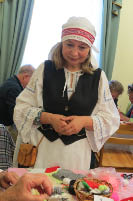
Petrozavodsk |
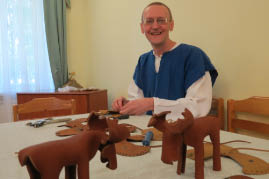
Petrozavodsk |

Petrozavodsk |
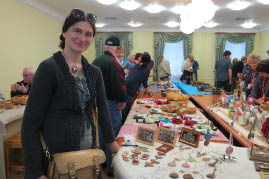
Petrozavodsk |
We stop at a market where Yulia does her shopping and had a look around. We also see where Yulia’s family lives on the 5th floor in one of those Khrushchev’s ghettos. Her parents, along with the rest of the folks in the Soviet Union, were given the apartment about 15 years ago – along with dacha (a summer home by a lake). Yulia’s sister’s children come and play in the forest just behind the apartment with her parents (their grandparents).

Petrozavodsk |

Petrozavodsk |

Petrozavodsk |
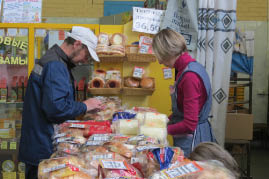
Petrozavodsk |

Petrozavodsk |
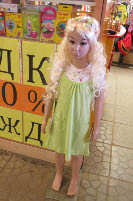
Petrozavodsk |

Petrozavodsk |

Petrozavodsk |
We return to the ship for lunch. It’s Bob’s 66th birthday so I get 66 candies from Oksana. During lunch, I get the key to Bob and Joan’s cabin and arrange the candies into the number “66.” Looked pretty cool – just can’t stop this endless creativity – he he he.

Bob's Birthday |

Joan & Bob |
After lunch, Bill and I walk back into Petrozavdsk to explore on our own. We stop at a bank to get money changed and then we’re ready to go. We see things like a bride and groom posing for wedding photos, statues of Marx, Stalin and other Soviet leaders and the remains of the old factory.
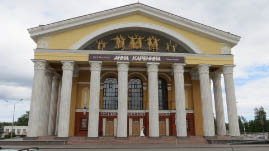
Petrozavodsk |

Petrozavodsk |

Petrozavodsk |
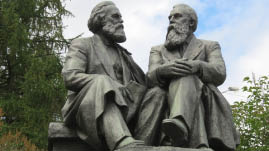
Petrozavodsk |

Petrozavodsk |

Petrozavodsk |

Petrozavodsk |
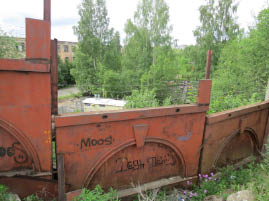
Petrozavodsk |
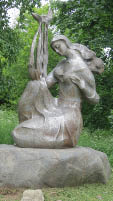
Petrozavodsk |

Petrozavodsk |
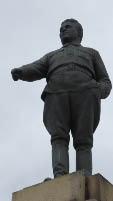
Petrozavodsk |
We see the church tucked away behind some trees, but when we head for it, we get painfully lost. The landscape is curved up by streams, lakes and hills.

Petrozavodsk |
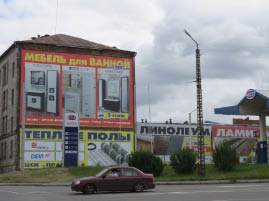
Petrozavodsk |
We must find a bathroom so we retrace our steps. Luckily the bathroom is in a little café which serves ice cream and beer. The beer is cheap, so we indulge. I am sure we are the main attraction at the café today – not many tourists find their way here. We are feeling better on our walk back to the bus.

Petrozavodsk |

Petrozavodsk |

Petrozavodsk |
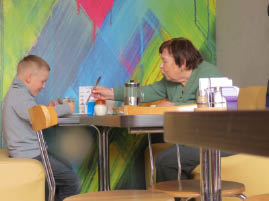
Petrozavodsk |
The town is making strides to become a nice place … but it has a way to go. The buildings and sidewalks all needed major concrete repair. The buses spew out fumes. And the place is covered with those awful Soviet apartment buildings.

Petrozavodsk |
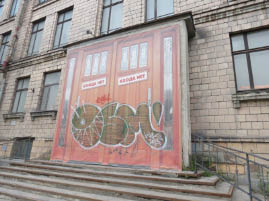
Petrozavodsk |
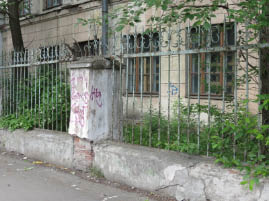
Petrozavodsk |

Petrozavodsk |

Petrozavodsk |

Petrozavodsk |
The gardens are the pride and joy along with the forests and riverside. It was fun watching the families out with the kids heading to the little amusement park down by the river. I was glad to see what life is really like – We have it soooooo good in the U.S.

Petrozavodsk |

Petrozavodsk |

Petrozavodsk |

Petrozavodsk |
At dinner, we sit with Birthday Bob, Joan, Terry and Freddie. Bob is a little grumpy with Joan – but they get over it. The staff comes out and sings to Bob and serve the folks at our table a yummy chocolate / creamy cake. Can’t believe I put away 2 desserts tonight!
Later, there is a presentation on Russian Fairy Tales. I get bored by the introduction and go back to the room to catch up on my journal. I missed the audience participation part. Bill was a hit as a “Wild Young Boar.” Sorry to miss out on the laughs while I was in my room pounding out facts about the trip.
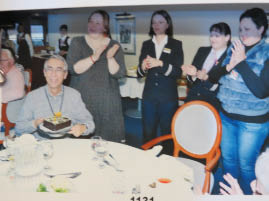
Bob's Birthday |

Wild Young Boar |
June 27 – Friday--Kizhi Island
At 8:30, we leave the ship to explore Kizhi Island. It’s a small island in the North West of Lake Onega, and at 62 degrees north, the furthest north we go.
Kizhi is one of 1650 islands in Lake Onega, the 2nd largest lake of Europe and located in the Republic of Karelia. In the first millennium AD, ancient tribes made their home here with Kizhi as the center of the region. Tribes would travel from the surrounding islands for their “pagan games.” Several pagan symbols for the sun are still attached to the buildings (to keep away evil spirits). Then, in the 11th-12th centuries, Russian peasants (or country people) settled here because of the fertile land. Soon Kizhi became an important meeting place for orthodox believers. The earliest mention of the Kizhi churches was in the mid 1500's.
As part of UNESCO World Heritage Site, Kizhi Island is now the largest outdoor open air museum in Russia with a collection of wooden buildings (wooden churches, houses, chapels, etc.) from all over Northern Russia. The architecture is typical of the craftsmanship of the Karelia region of North Russia.
We meet Nadia, our guide. She is a wealth of knowledge and has a great sense of humor. Kizhi has a population of about 90 people. Nadia lived in Kizhi for 25 years, working for the museum; yet she is not considered a local.

Nadia, Our Kizhi Guide |

Yulia |

Photographres/Mucisians |

Nancy, Bob, Joan, Bill |

Kizhi Island |

Kizhi Island |
We walk down the road from the ship dock to the Island and are mesmerized by a bell-tower and two prominent churches within a surrounding wall. The tallest cluster of onion shaped domes tops the Church of the Transfiguration, originally intended to hold services only in summer months. Notice that the Church of the Transfiguration has no foundation – it’s held up by wooden planks while its being rebuilt. The other church, Church of Intercession, is topped with a smaller collection of domes. The church bell tower stands next to the churches. The Bell Tower, along with the Church of the Transfiguration and the Church of the Intercession, has a total of 31 onion shaped domes. No nails were used in the construction because nails were too expensive. Get this – back in those days, 10 nails equaled the price of one cow. Everything is held together with wooden pegs or sometimes pieces of wood were notched together to form even the most intricate structures. We will explore this later in our visit.

Kizhi Island |

Kizhi Island |

Kizhi Island |

Kizhi Island |

Kizhi Island |

Kizhi Island |
Overview of the Island:
Besides these main churches and bell tower, there are many other buildings on the premises -- homes, fish-houses, granaries, saunas, windmills, barns and chapels -- all from the Karelia region. They were dismantled and brought to the site to be reassembled as they were. In addition there are two villages within the island with wooden homes where the majority of people here are farmers.
This area is made up of islands. In by-gone days the cattle were rowed by boat ashore to other islands for pasture. They were protected because wolves could not swim across the water to get to them. However, the wives had to row a boat to the cows twice a day to milk them – just another chore added to a long list.

Kizhi Island |
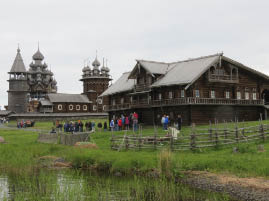
Kizhi Island |

Kizhi Island |

Kizhi Island |

Kizhi Island |

Kizhi Island |
The fences were built at an angle so high winds would not blow them away. The folks here were very clever.

Kizhi Island |

Kizhi Island |

Kizhi Island |
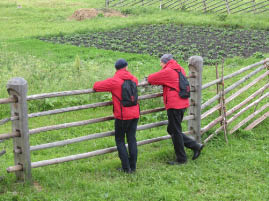
Kizhi Island |
Structures We Visited:
Typical Peasant's House - inhabited in the last century, but now is part of the museum and combines the barn (in the lower level), the main living quarters and the workshop on the top floor. This particular old farmhouse was much nicer than most because the owners were merchants. Our guide, Nadia, describes how up to 25 people, many generations of one family all lived together in this house at one time.
The barn is attached to the backside of the house. In the brutal winters, the animals stayed in and were cared for in the warmth of the attached barn. Usually very large families all lived together in these large houses, caring for each other and the animals.
In the living area, we see the table, cabinet, shelving, and large stove (on top is where the older people and children slept for warmth). The family also had Russian teapots, called Samovars. They were very expensive pieces of equipment and heated the water for tea with hot coals on the outside. Every family had one – almost a requirement. The merchant family living in this house owned 7 of them. We watch a woman spinning yarn and a young maiden beading a necklace.
The top floor is a workshop where we find weaving looms, sleds, horse harnesses, and a boat designed not to take on so much water.

Kizhi Island |
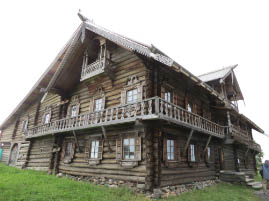
Kizhi Island |

Kizhi Island |

Kizhi Island |

Kizhi Island |

Kizhi Island |
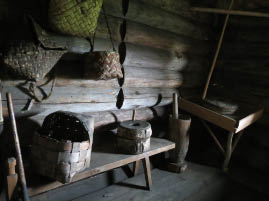
Kizhi Island |

Kizhi Island |

Kizhi Island |

Pagan Symbol to keep away evil |
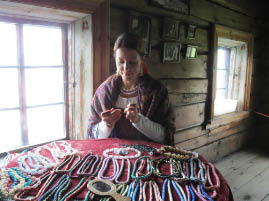
Kizhi Island |
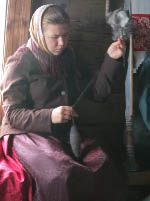
Kizhi Island |
Granary -- outside, a little house is used to store the grain. A cat is necessary to keep the mice away. Right outside the granary a local guy was carving wooden toys, for purchase, of course.

Granary |

Wood carver |
Bathhouse — built without chimneys and heated with coal. However, now the saunas are heated by electricity. The steam gets so hot that the bathers must run out and jump in the cold lake to cool off. Ahhh, Russians love their saunas. However, the children would scream because it was so hot. To keep them quiet, their elders would tell them if they made a sound, a witch or something equally evil would eat them. Today, Nadia says the people who work at the park take saunas here twice a week and really look forward to it.

Sauna |

Sauna |
Church of Lazar of Murom (AKA Church of the Resurrection of Lazarus) -- oldest wooden church in Russia built in the middle of the 14th century and moved to the island in 1960. It was originally a monastery and believed to heal the people. If one had a tooth ache, gnawing on the wood would cure
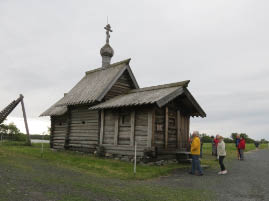
Church of Lazar of Murom |

Church of Lazar of Murom |
Windmill -- make a lovely scene on the island (originally from the village of Volkostrov)

Windmill |
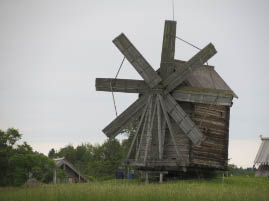
Windmill |
We circle back around and explore the church complex behind the wooden wall.
Grave Markers – Right inside the wall, we see the reproduced grave markers.

Grave Markers |
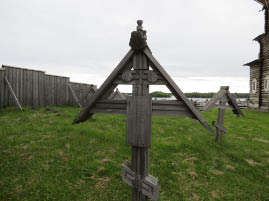
Grave Markers |
Church of the Transfiguration -- The biggest of the structures is the Church of the Transfiguration which was built on the island in 1714, in honor of the victory of Peter the Great over the people of Sweden. The church was used during the summer for major holidays. All four sides of the church are identical so everyone on the island has the same view.
The wooden cathedral is supposedly built by one man, Nestor, and without the use of nails. It has 22 timbered onion domes covered with 30,000 plates made from aspen wood. Legend has it that Nestor threw away his hammer when the church was completed and swore there would never be another like it. There isn't. It is an amazing structure with the cupolas made of Aspen and so perfectly round. For many years great church celebrations were held in this church with people from all over the area attending. (By the way, Nestor built this church without any measurements or plans – just turned out to be even shaped 22 onion domes – how can that be?)
The Church of the Transfiguration has no foundation. It’s being rebuilt for the 300 anniversary (1714 - 2014). Restoration is going full swing for the big day. Nadia tells us that we can watch the restoration on the churches on a live mini cam on the internet – Ain’t life grand?!?!?

Church of the
Transfiguration |

Church of the Transfiguration |
Church of Intercession – built in 1764, standing next to the Church of the Transfiguration, is the winter church. In this frigid land, it was common to pair churches for winter and summer. Winter churches are smaller and require less heat for a fewer number of worshippers. Inside the church are beautifully colored icons and frescoes that lined the wall. People pray to the icons -- the more praying, the more spiritual power the icons generate. We learn that in 1937, under the Soviets, church service was halted here. The last two priests were executed to ensure that law was followed. Those Bolsheviks were something. But today, the church is back in business.

Church of the Intercession |

Church of the Intercession |

Church of the Intercession |

Church of the Intercession |

Church of the Intercession |

Church of the Intercession |

Church of the Intercession |
Bell-Tower -- The bell-tower in the church was added in the year 1874 and the walls feature horizontally fitted logs being covered with wooden planks. These wooden planks were removed in the 1950s and new horizontally fitted logs have been added. In the present days the church is being modified as a part of its 300th anniversary that is to be held in the year 2014.

Church of the Intercession |

Church of the Intercession |
We walk around town and back to the boat. On the way we stop and chat with Captain Constantin who is fishing in the river. Others have joined him. They have only caught a hand full of fish. The Captain tells us that his family is in the boat business and that his grandpa was once a captain.

Captain Constantin |

Ships Waiting for Passengers |
We return to the ship about 10:30. The ship lives at 11 for the next stop, Goritsy. We go for a brief orientation about Goritsy and the tour of the monastery.
We have a big lunch (of course) in the dining room. We sit with Jill and Ken and Bob and Joan (of course).
We watch a program on the Russian Czars and forgo the cooking school presentation.
At 3:30, the captain shows us around the bridge. The ship was built in 1977 and was remodeled about 5 or 6 years ago. It’s very comfortable, but the instruments look a little aged – like they are from the Dr. Spock era.

Captain Constantin |

Ship's Control Panel |
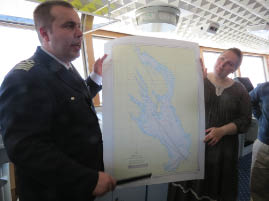
Captain Constantin |

Ship's Charts |
Yulia shows us a map of Russia and gives us a perspective on the distances and cultures. Very interesting. Our next entertainment is at 5 pm when there is a special cocktail party for the inner circle travelers – e.g., people who have gone on 3 or more OAT / Grand Circle trips. One guy has been on 36 trips!
After the party, we go on deck to watch the ship go through another lock. Joan and I stand at the helm of the ship and do back stretches at the front of the ship. Later, we learn that we had our butts up in the air in full view of the ship’s intercom camera which feeds video of our rear ends into all the rooms. I couldn’t stop laughing when I learned that we were afternoon stars (by just mooning!). HELP – We’re out of control goofy.
We sit with the Greek Gals – Kathy, Molly, Alice and May for dinner. They are all having stomach problems. We have a huge dinner – Russian Market Buffet. Reminded me of Nadia’s cooking.
It’s 10:30 p.m. and the boat is jerking and yanking around. I look out my window (in the bright light) and discover we’re wedged in between a lock. What fun! Better take an extra sleep aid tonight!
June 28 – Saturday
Bill and I are tiring of the big breakfasts and big meals – but we carry on. Life’s is tough when you never ever know hunger … Thank you universe.
The rivers and lakes between St. Petersburg and Moscow (about 1,000 miles) offer pretty much the same, pleasant scenery – occasional little towns that appear charming, pastoral scenery, woods, all lined with verdant banks. We also see signs of logging, lots of it.

Scenes from the River |

Scenes from the River |
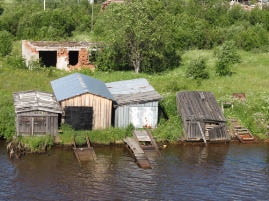
Scenes from the River |
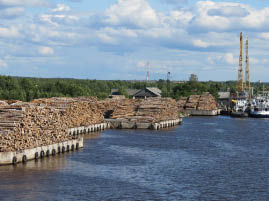
Scenes from the River |

Scenes from the River |

Scenes from the River |
At 9, we have another amazing talk by the guide, Jenia. This time she focusses on Modern Russian History. Again, we were all blown away.

Jenia |
Jenia’s Talk – Russia for Dummies
Soviet Union formed in 1922. People thought Lenin's Soviet-style Marxism was a great idea – but no way to implement it. (Plus reconstruction after the war wasn’t easy.)
In 1924 Lenin dies. 1928 was the beginning of industrialization and the tragedy of collectivization of peasants (collective farms).
Stalin was cruel and only cared about power for himself and was a genius at purging his enemies with his secret police.
1941 – 1945 awful battles in Russia during WWII with the Germans. Victory comes on May 9, 1945.
1945 – 1953 Stalin’s post-war period ushered in the cold war and arms race.
1953 – 1964 - Khrushchev takes over. He was an idiot (hey -- we’ve had our share of idiot leaders), but the visit to U.S. (even with shoe pounding drama) was the beginning of the cold war thaw. He created Khrushchev Slums – temporary housing that are still holding people today – but give him credit -- he did try house the people. Also to his credit, he limited the arms race with the U.S.
Sputnik and the first manned flight into space (Yuri Gagarin) helped boast Russia’s spirits and national pride
1964 – 1982 Brezhnev period – more blocks of butt ugly apartments.
1985 – 1992 - Gorbachev’s glasnost and perestroika. I always liked Gorbachev with the strawberry colored mark on his head – but the Russians despise him. He messed with their pensions – not a popular thing to do.
1991 – Break up of the Soviet Union and years of stagnation – really rough on the people and after all they’ve been through.
1991 – 1999 – President Boris Yeltsin – a total idiot and drunk. He announced his resignation at the Millennium New Year’s Eve party leaving the country in mass confusion. Market crashes, devaluation, long lines and rule of the Russian Mafia wiped out the middle class. Jenia said that the Mafia members that somehow managed to stay alive, took their money and are now living in the U.S.
Hope came in 2000 with President Vladimir Putin, but his ties as the head of the KGB never left him. He is now rich and powerful and cunning (the Olympics were a huge coup). He has also figured out a way with Dimitry Medvedev (trading off between Prime Minister and President) to rule the country forever. There is stability, but now that the people have some food in their tummies and have some time to think about Russia’s new political mess, they tend to get a little restless. Scary.
We learned from Jenia what it was like to grow up in Russia during these troubled years. Her grandfather was forced to share his big 7 room home with 5 other families. Her father found out about Chernobyl just in time to cancel his family’s move. It is awful to have the government cover up such things. Her father started a business with metals and made a lot of money in the first week – then got the call from the Russian Mafia. They demanded a huge on-going price from him to keep his business – otherwise they knew his daughter’s name and where she went to school. So many tragedies to endure. |
Jenia was very outspoken and honest about the issues. She didn’t mince words. I hope she is safe. Right after her powerful talk, we change the topic to food and have a "Blini party." Our chef Aleksander (along with his sidekick, Garon) shows us how to make and, more importantly, how to flip a blini. Blinis are the Russian version of crepes, or thin pancakes. A variety of fillings can be folded into the cooked blinis for a real Russian treat. I am first in line. I fail miserably on the flipping part. My blini lands on the heating element making a terrible mess – more laughs, more goofiness.
We lunch with Bill (Episcopalian minister), wife Lee Ann and Dolores and Nicole (grandma and granddaughter team) – very pleasant.
We disembark and board the bus for the town of Goritsy, only a few minutes away. From the boat we see the Kirillo-Belozersky Monastery in the distance, along the bank. It’s the oldest and largest in Russia built in 1397 by St. Kirill and our destination for today.

Goritsy |
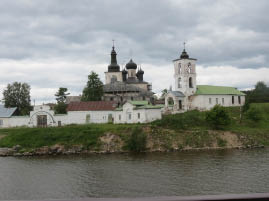
Goritsy |
We take a guided walk through the monastery’s historic grounds. Once inside the monastery’s walled area, we see the Assumption Cathedral, a museum, small wooden chapels, and other structures, most of them dating to the 16th century. However, we are unlucky with our tour guide. She rambles on and on and we didn’t get much from her talk.

Kirillo-Belozersky Monastery |

Kirillo-Belozersky Monastery |
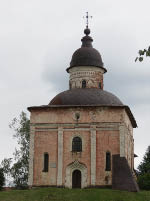
Kirillo-Belozersky Monastery |
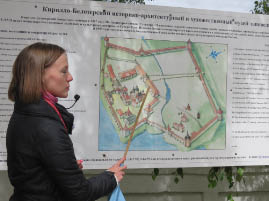
Kirillo-Belozersky Monastery |

Kirillo-Belozersky Monastery |
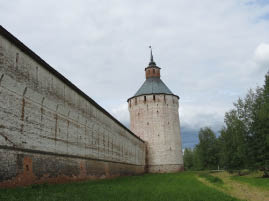
Kirillo-Belozersky Monastery |

Kirillo-Belozersky Monastery |

Kirillo-Belozersky Monastery |

Kirillo-Belozersky Monastery |
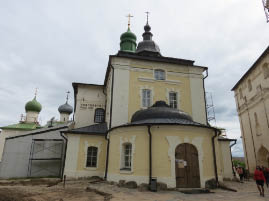
Kirillo-Belozersky Monastery |

Kirillo-Belozersky Monastery |

Kirillo-Belozersky Monastery |
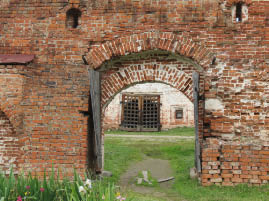
Kirillo-Belozersky Monastery |

Kirillo-Belozersky Monastery |

Kirillo-Belozersky Monastery |
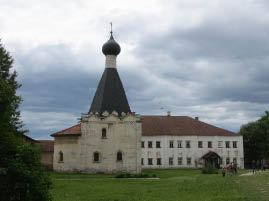
Kirillo-Belozersky Monastery |

Kirillo-Belozersky Monastery |
Kirillo-Belozerskiy is the largest Russian Orthodox monastery / Goritsy nunnery in the world. At one time there were about 1,400 monks living here – now there are 6. (I have a single monk sighting. He was opening a door.) Saint Kirillo, a wealthy kid who became a monk, founded the monastery in 1397. He left a life of luxury to look for a remote place to become closer to God. His new monastery prospered and later, became a refuge. By the 16th century, the monastery was the second richest landowner in Russia. The monastery turned into a fortress that resisted attacks for many years. The monastery walls, about half a mile long and almost 23 feet thick, were constructed in 1654-80 to hold off Lithuanian invaders. The walls held off other invaders as well – but they couldn’t stop the Bolsheviks. The Bolsheviks ordered the monks shot or sent to labor camps. They also destroyed many of the buildings. However, the monastery managed to hang onto much of its historic grandeur and was selected one of the “the New Seven Wonders of Russia.”
The monastery has a large collection of 15th and 16th century icons with diadems (attached halos). I paid a camera fee for the right to snap these photos – not a good choice. The icons looked the same as the ones in other churches. (I learn later that the silver icons shields made with openings for faces / hands, were used to cover and protect the icon paintings. The constant smoky candles in the churches could do a lot of damage to these great works of art.)

Kirillo-Belozersky Monastery |

Kirillo-Belozersky Monastery |

Kirillo-Belozersky Monastery |

Kirillo-Belozersky Monastery |

Kirillo-Belozersky Monastery |

Kirillo-Belozersky Monastery |

Kirillo-Belozersky Monastery |

Kirillo-Belozersky Monastery |

Kirillo-Belozersky Monastery |

Kirillo-Belozersky Monastery |
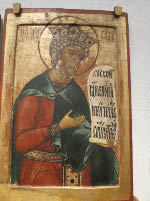
Kirillo-Belozersky Monastery |

Kirillo-Belozersky Monastery |
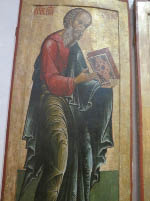
Kirillo-Belozersky Monastery |
The nunnery is famous for its flower gardens and the exquisite icons and embroideries that have survived over the years. Both the monastery and the nunnery have historical connections with Ivan the Terrible. Before Ivan was born, his parents prayed to God to give them an heir – He did. Then when Ivan was dying, he begged the monks here to pray for God to forgive him for his terrible, bloody deeds – We don’t know if He did.
We walk through the monastery complex and out the back gate down by the White River. It is a peaceful lake lined with quaint little summer homes (dachas). Each year during a Winter Festival, the residents (and other crazy polar bears) jump into the water. It is said that the lake has powers to make them younger.

Goritsy |

Goritsy |

Goritsy |
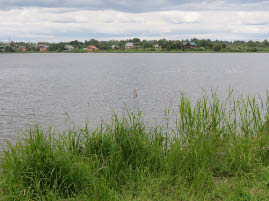
Goritsy |
The monastery grounds were very serene and very authentic, but I left without a sense of the history of this place. We say good-bye to our annoying tour guide and then the sprinkles start again. The town is celebrating it's birthday. We see lots of people out with their kids having fun – they’re used to the rain. I see a sad little lady. I take her photo as she turns her head. However, she is very appreciative of the few rubles I give her.
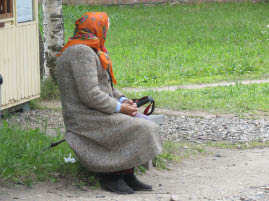
Goritsy |

Goritsy |
We stroll through the outdoor market offering mostly junky stuff of the “made in China” vintage. Sprinkles come down harder. The bus comes and we are glad. On the way back to the dock, we drive through a little village with cute little houses and a War Memorial to its fallen soldiers. However, the town folks only paint the front of their houses. Why waste paint on the parts you can’t see? Very practical people – something Max, a former Ukrainian neighbor, would do.

Village Near Goritsy |

Village Near Goritsy |

Village Near Goritsy |

Village Near Goritsy |
We come back to the ship for a planned activity – painting Matryoshka Dolls. There are a lot of talented artist on board. I am not one of them. Mine is very stupid, as you can see.

Matryoshka Dolls |

Matryoshka Dolls |
Next activity is Vodka tasting. We try about 3 different kinds. Much to my surprise Vodka doesn’t make you drunk, only happy.
After dinner, Joan and I went to the Karaoke Night. We were going to sing a duet – “Doe, a Deer.” However, after we see some of the others perform (ones with real talent), we decide best not to make bigger fools of ourselves. The orange group of Chinese travelers from Dallas have all the talent – dancing, singing, painting, beauty. We did dance with Yulia and had a lot of fun.
I come back to the room to shower and catch up on the journal – the never-ending journal.
June 29 – Sunday – Uglich
It’s a beautiful, bright sunny day – We’ve waited a long time for this sunshine. But it turns out to be a sad day after all because I check my Facebook and learn that Dale Larabee, a truly good guy who is a leader in our neighborhood community, died this morning after his morning run. What a shock! He was our age and very fit. We’ve known him for over 40 years. We are sad for his wife and our loss.
We do manage to go to breakfast. After breakfast, we listen to a talk on Uglich, the town we’ll be visiting this morning. Later, we watch the town come into view – beautiful.

Uglich |

Uglich |

Uglich |
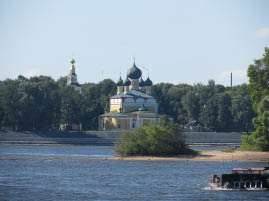
Uglich |

Uglich |
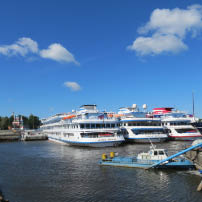
Uglich |
At 10, we disembark for a walking tour of Uglich. A rag-tag band plays ump-pa-pa music for us as we climb the steps to the bank. We meet our lovely guide and head for town.

Uglich |
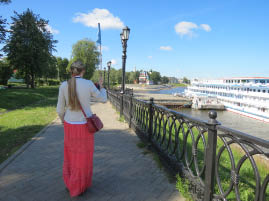
Uglich |
Uglich, population of 37,000, was founded in 937 – over 1,000 years ago. Located 136 miles north of Moscow, it was built as a fortress next to the Volga River (where the river makes a sharp curve.) Amazing churches and palaces sit behind the fortress walls. Of course, as in all these little towns and villages, there are statues and a memorial to the WWII fallen soldiers.

Uglich |

Uglich |

Uglich |
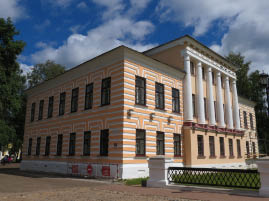
Uglich |
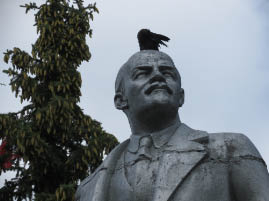
Uglich |

Uglich |
I really like the vibes of this ancient town. It was also a favorite of Ivan the Terrible in the 16th century. He sent his 7th wife there when he tired of her (a thing that Czars did quite often). After Ivan died, Dmitry, his 7 year old son (the only heir to the throne) was sent to be with his mother. In a plot to take the throne, Boris Godunov had the boy assassinated on May 15, 1591. He got away with it and later acceded to the throne. 100 years after the boy was killed, a colorful, red Church of St. Dmitry on the Blood was built 1692 and the boy was made a saint. The church was grand with amazing icons that told the story of the kid’s death. (I didn’t pay the camera fee – but trust me, they were stunning.)

Uglich |

Uglich |
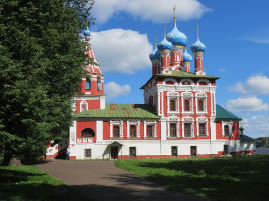
Uglich |
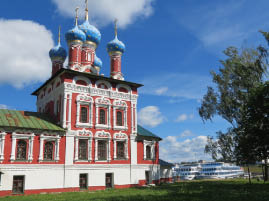
Uglich |
We also visited the green domed Transfiguration Cathedral (1713). We see a priest involved in some post game priestly interaction. I buy an icon from the church to give to Amy. (Joan helps me pick it out. It has a lot of red on it. She likes red.)

Uglich |

Uglich |
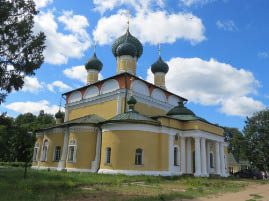
Uglich |

Uglich |
The highlight of our visit was listening to a 6 member men’s choral group sing 2 pieces. Their voices blended like one amazing instrument and blew us all away. I thought about our friend Dale as I listened to the heavenly music – music we’d never heard. The music is haunting and so are the portraits behind the singers. It is as if the ghosts of the town’s past are looking over their shoulders. We buy a couple of CD’s, of course.

Uglich |

Uglich |

Uglich |

Uglich |
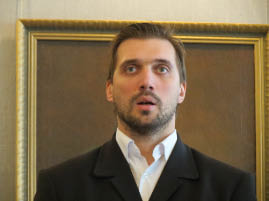
Uglich |

Uglich |

Uglich |
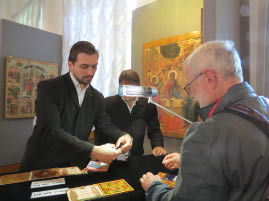
Uglich |
Yulia and other crew members meet us in the courtyard. They are dressed in their royal garb from the 16th or 17th Century. Nice touch – great fun. We had our photos made to commemorate the moment.
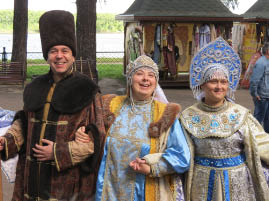
Uglich |
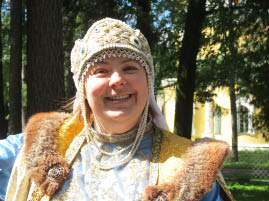
Uglich |

Uglich |
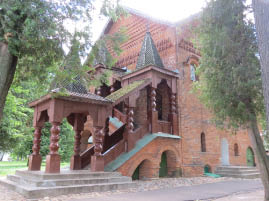
Uglich |
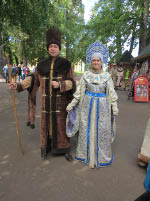
Uglich |
We check out a cute little yellow house where a master lacquer box maker / artist sells gorgeous lacquer boxes. We are taken away by their beauty, but they are too expensive for our blood.
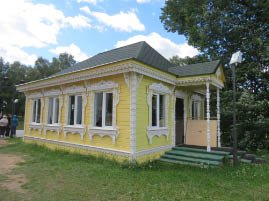
Uglich |

Uglich |
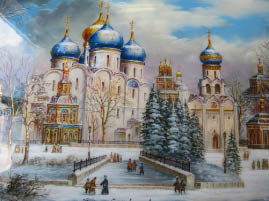
Uglich |
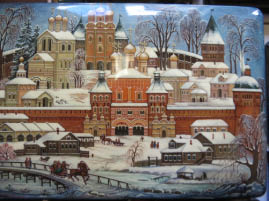
Uglich |
Bill and I take off to check out the main town. It’s known for its cheese, called Russian Cheese, and for its decorative watches that look nice, but are not reliable. We walk back to the ship along a row of vendors. Word is that this is where to buy stuff – cheaper and better than what we can find in Moscow. Bill must endure about an hour of my shopping, buying things we really don’t need and things our friends and family really don’t need or want. But, hey, you got to do it!
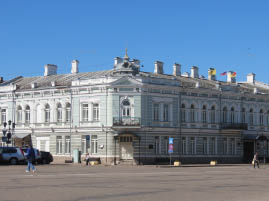
Uglich |

Uglich |

Uglich |

Uglich |
Our ship sets sail for Moscow at 1. We settle in for a nice long filling lunch. Bill and I order hamburgers and fries served with soup and salad and an ice cream sundae. We waddle back to our room fat and bloated. This behavior has got to come to an end.
At 3 pm, we attend a Q&A program with our program directors. They are very candid on topics such as Putin, Ukraine, Same Sex marriage, etc. I keep dozing off because of the warm sun and full belly.
The PA announces that the Flooded Belfry of Kalyazin is in sight. We all run out to the decks to snap photos. The bell bower stood in the waters, showing about half of itself – a beautiful and sad sight at the same time. It was built in 1800 as part of the St. Nicholas Cathedral on Kalyazin’s Market Square. In the 1950’s, much of the town was flooded and the Kalyazin citizens had to move to higher ground. Now Kalyazin has a population of 15,000 and is famous for its felt boot factories.

Flooded Belfry of Kalyazin |
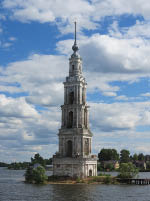
Flooded Belfry of Kalyazin |
Bill and I look through the photo books taken by the staff and pick out a few. The Matryoshka Dolls (nesting dolls) we painted yesterday are on display for voting. Bill overhears one passenger saying that my doll is “scary.” Later, I approach her about her comment. She is embarrassed and I have a lot of fun with her.

Nancy with her
artwork |
At 6:30, we go to the Captain’s Farewell Cocktail party. The room is crowded and noisy and I can’t hear much that’s said so I just flash my goofy smile. Afterwards we have the Captain’s Farewell Dinner. We sit with Bob and Joan and Kathy. We talk about the trip, about death and anything that pops into our minds.
I have a short, heart to heart chat with Oksana, manager of the front desk. She’s had a tough life. Her mother died 2 years ago – I thought she said the cause of death was crabs – but that can’t be.
After dinner, we go to a cute variety show where there are silly skits – men dancing as Russian ballerinas, Garon (the hotel manager) playing the part of a statue in a pretend fountain where girls spit water at him. Everyone has such fun.
We come back to the room to settle down to our duties – washing and journaling. Moscow tomorrow -- Can’t wait.
It’s 11:30 – I just looked outside and it is DARK outside. Haven’t had a dark night in weeks – going farther south. I look forward to a night without the sun.
NOTE: I sleep very well in the complete darkness – feeling good for our first day in Moscow.
|











